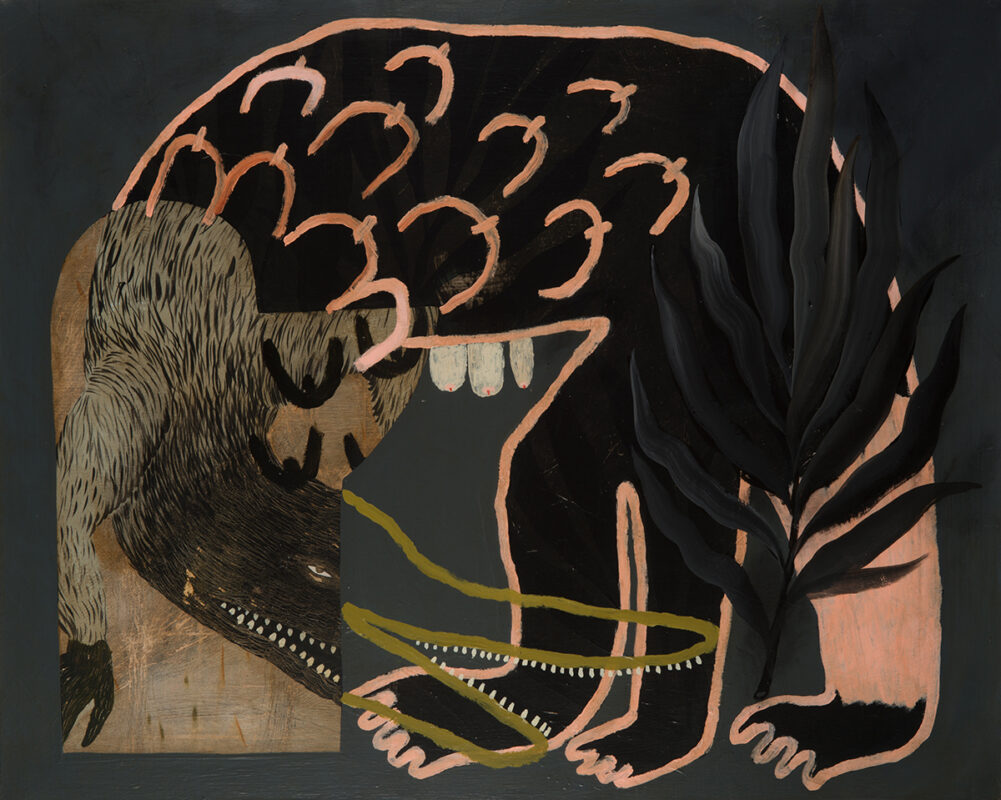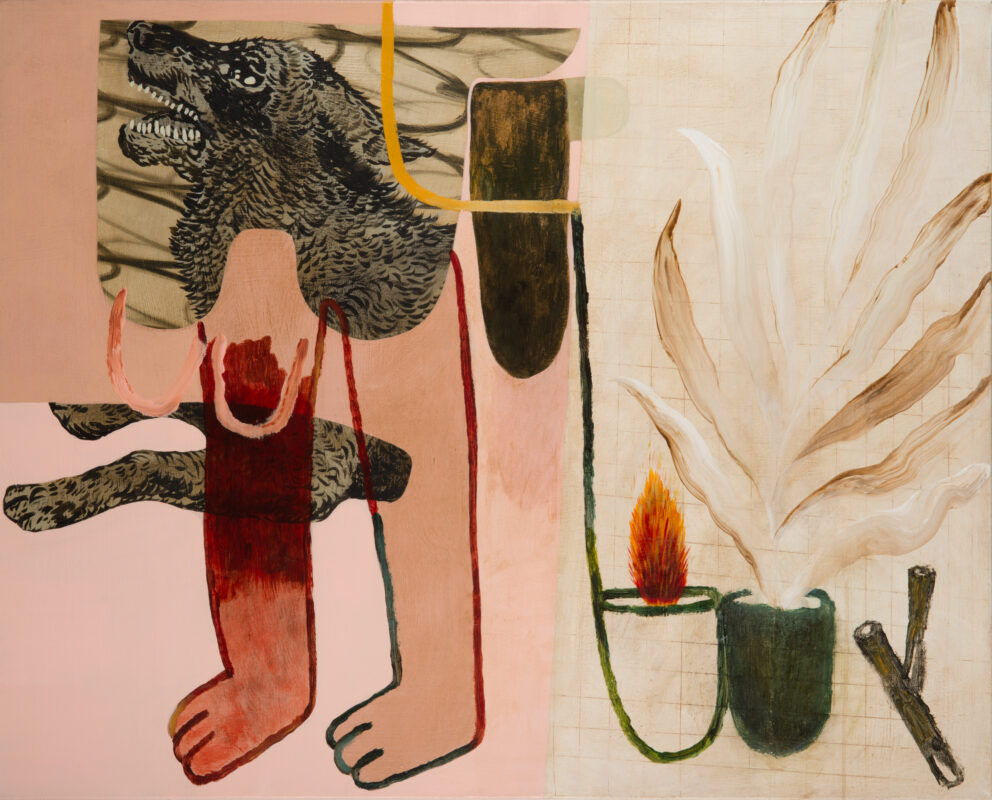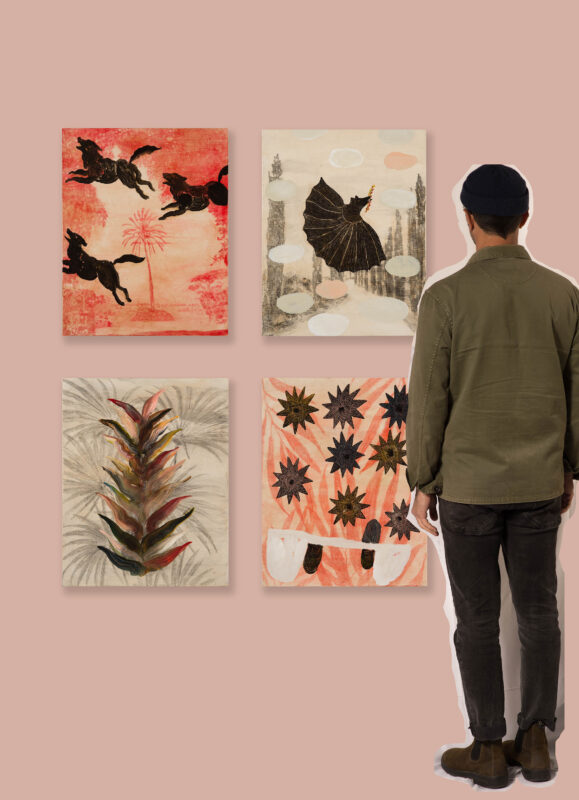HIDEBEHIND
by Caterina Frulloni
Hidebehind is literally ‘what hides behind’ which by its very nature always eludes us. It is such a frightening concept that among the popular folklore of the Minnesota and Wisconsin inhabitants, embodies a huge dark monster with feral claws: a creature with the uncommon habit of hiding behind its victims' back, where they are unable to see it. The Hidebehind haunts what structurally, for a mockery of our own physiology, we are not allowed to explore or control: that always blind, shady portion, that our gaze will never be able to reach.
Yet those hidden, endogenous sections are at the origin of the figurative universe of Matteo Giuntini and, in their partial emergence, they constitute its being. In a direct dialogue with the centuries-old practice of cancellation – which finds its most mature representative in Emilio Isgrò – the pictorial transformation by stratification has always been essential for the artist's technique: starting from a visual mistake, he is capable of rethinking the picture, formally creating his paintings. However, the overlaps, the "hidden behind", achieve a new narrative value: now the starting point is an already complete painting which is progressively concealed behind unpredictable outcomes, and which comes to fruition in unexpected and imaginative concatenations. What Matteo Giuntini aims to create is a narrative engine, an "archeology of the hidden", to which a careful observer must pay close attention in order to commit himself in reconstructing the absurd tale displayed by the artist. Giuntini chooses the form of alteration with awareness, outlining a history of the ‘hidden’ to be traced, through animal and vegetable labyrinths, where the metamorphoses between beings rise extraordinary bestiaries, accompanied at times by primitive graffiti. The power of the transformative mechanism, which only partially reveals the underlying variation, enriches the semantic of the artworks, founding itself in a game of allegories, which drive their references into surreal interpretations. The erasure distorting the painting is never a destructive act, but it consecrates its questioning. Its identity remains in the making process: it is never predictable, never definitive, but accepts the extraordinary spontaneity which is emblematic of an artistic creation. Thus, in "The Photosynthesis of the Cut Flower" faces bloom from green stems, but on one of them a fierce wolf head has been decisively painted, interposed between dark, archaic wedge-shaped signs, as if the artist was willing to reveal his curiosity about the superimposition between the beast and human mask. This is how the transformation overturns the point of view of the protagonists of the canvas, consigning the tale to one of its infinite representations.
The reference to the subculture of graffiti and to Basquiat's canvases led at the same time to discordant and surprising results, where the use of heavy but soft, elementary and archaic brushstrokes is overlapped by the almost fairy-like decorative context, led by pastel colors and the recurring use of light pink. Even the unique games of correspondence between images and the written word - a strong surrealist matrix - included by Giuntini in his previous productions, is now absent, absorbed by the allegorical references of the figures, even if it is retained in the trivial titles of the paintings. The characters populating the canvases re-emerge from a remote collective psyche, which showcases medieval bestiaries and the "naïveté" of primitive paintings and recall, in the floral shapes of the stars and in the compact appearance of the dog-wolves, Kiki Smith’s production of drawings and papers dated after the year two thousand. The mythical aspect of the figures is accompanied by a certain narrative "melancholia", which leads back to the visual power of Georg Baselitz's German Neo-Expressionism, but also to the pictorial tones of Sigmar Polke. The artist's affection for the elementary but personal representations of the "Ex Voto" engravings seems to be evoked in the macrocosms of the paintings; for instance in "Fusaggine" arms of childish manufacture floats, tending to a vegetal shaped flame. However, an essential feature not to be ignored is that the artworks‘ titles invite to call upon a constant dimension of irony, which turns each painting into a "theater of the absurd" and highlights the Tuscan hometown and birthplace of the author, which is Livorno.
The juxtaposition word-image, which in the previous production attracts the observer to get lost in the artist's wild labyrinth, is now absorbed in the universe of meanings suggested by the figures: the undisputed master in the Feast of Fools evoked by the painter. Therefore, a sort of illustrated paradoxography emerges, where various "mirabilia" give life to a bestiary of the incredible, made up of new fantastic creatures, alien to common sense. Combined and overlaying species belonging to several kingdoms and genres, together with animals and plants, blooming human beings and women with beast-like feet. There is "Meringo" the as black as the night crocodile, which body is covered with pink scales as sort of udders and supported by three large legs; the pack of rampant dogs-wolves in "Home’s Bourgeois Carpet" and then, the big bat "S. Piero" flying between rows of cypresses with its wings-mantle, carrying an olive branch in its mouth. This absurd universe is fantastic and democratic, primordial and free at times, where the masculine and the feminine, the man and the beast, the stars and the plants are all active protagonists of the same narrative, altered and hybridized one another, mixing their attributes and their specific qualities.
What is certain is that when faced with the hidden and furtive "Hidebehind" of Giuntini's pictorial language, we cannot help but feel the ancient feeling of wonder, nor can we fail to lose ourselves naively in his free and impossible worlds.




